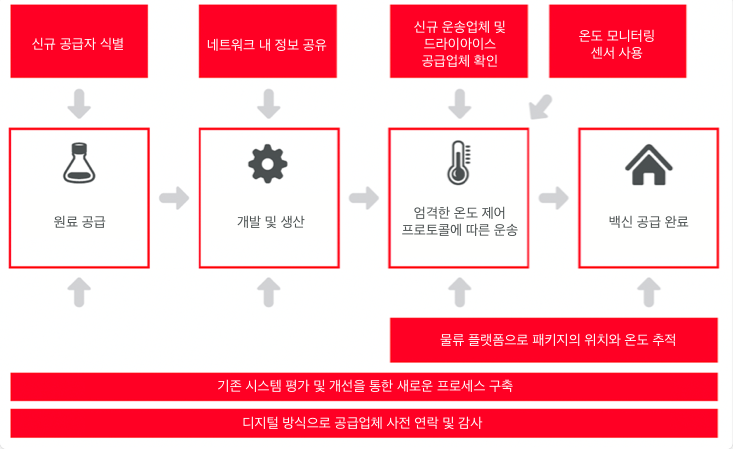mRNA Vaccine Development Timeline: COVID-19 Learnings for a Pathway to Success
Category | Advanced therapy
The rapid advancement of the Pfizer-BioNTech and Moderna messenger RNA–based COVID-19 vaccines from lab to clinic—with development taking less than one year—has validated the mRNA platform and driven interest in application of this technology for many indications.1 Thermo Fisher Scientific has extensive experience in vaccine development, manufacturing and supply chain logistics – supporting pharma companies in drug development and delivery to patients. Through this experience, Thermo Fisher Scientific has gained valuable insights into the critical role that it can play in driving the development and manufacture of next-generation vaccines and therapeutics going forward.
Challenges and lessons learned
Innovation and collaboration among the world’s leading drug manufacturers helped bring the COVID-19 vaccines to market. This innovation and collaboration could also help bring to market additional safe, high-quality mRNA-based products in the future. However, delivering on the promise of mRNA technology for other pathogens will require solutions to complex formulation, delivery, and scale-up challenges. The challenges to overcome fall into three main categories:
1. The unique attributes of mRNA vaccine development
- Molecule instability and degradability
- Low uptake rate in vitro
- Large molecular size
- Low immunogenicity
- High toxicity or inflammation potential
- Cold chain manufacture and storage requirements
Researchers and drug delivery experts have gradually overcome these challenges, developing successful strategies to stabilize mRNA, increase cell uptake, reduce toxicity, and simplify and standardize production.
2. Need for a paradigm shift in planning to address process challenges and streamline workflow
Traditional vaccine development takes 8 to 14 years on average, while emerging platforms have allowed extremely rapid preclinical development times of as little as 14 to 42 days.2 This has enabled viable vaccines to be launched with emergency approval in less than a year. Barriers to overcome for rapid production of mRNA vaccines have included the need for high levels of purity and precision, with strict quality control and avoidance of degradation and contamination; sterile filtration, stability, and purification considerations; and cold chain maintenance. Capacity planning is also essential, with global vaccination programs requiring millions of doses to be produced by networks of facilities. To overcome these barriers, companies should consider partnering with a CDMO offering a global footprint that can provide support for the complete workflow—including streamlined end-to-end integrated services and advanced workstream management techniques—and can overcome supply chain limitations.
Learnings from efforts during the pandemic indicate that a more rapid launch of clinical trials and earlier work on manufacturing solutions can accelerate the development timeline without compromising quality. This approach requires that workstream processes be carried out in parallel rather than in sequence. While an appropriate delivery system remains paramount, it may be possible to reconsider the priority scale for steps such as optimizing the manufacturing process and selecting the final dosage form, helping to enable earlier market access. Risk management is a fundamental part of this approach, as it delivers important benefits including streamlined development, early recognition of manufacturing challenges, and the ability to address these challenges before full-scale production begins.
Once plasmid production and the delivery system have been optimized, mRNA vaccine production has a significant advantage, even if the target disease changes. The encoded antigen can be switched out during synthesis and the rest of the production process will remain the same. This offers the potential for many vaccines to be made using a single delivery system and manufacturing process. If a single CDMO manages the entire workstream, additional efficiencies are gained across teams and facilities.
This reduction in development timelines will accelerate the time to market of future vaccines, including those unrelated to a pandemic. Simultaneous efforts in research, clinical trials, and manufacturing processes can reduce timelines with less risk than in other fields of medicine.
3. Global supply chain implications and the necessary investments and innovations
For the successful manufacture and distribution of vaccines, all necessary raw materials and qualified transportation options must be available. During the pandemic, pharmaceutical product supply chain experts turned to express carriers, collaboration, and proactive monitoring technology. This experience yielded adjustments to vaccine development and manufacturing that can be used for all vaccines in the future, helping to streamline processes and reduce risk. Two major lessons learned by CDMOs were that transportation challenges could be eased by identifying new cargo shipment options, including use of express carriers rather than commercial airlines for freight; and that virtual audits and digital monitoring technology enabled use of suppliers and carriers without previous cold chain experience.
Solutions successfully used during the pandemic to allow vaccine distribution include:3
- Temperature sensors in every shipment to provide a record of temperatures, with accurate information about any temperature excursions, even when employing new shipment options.
- Advanced monitoring platforms to allow remote and visual monitoring of package locations from a computer dashboard. This technology can be paired with temperature sensors, enabling any transit-related issues to be addressed.
- Digitalization and connectivity among suppliers, vendors, and collaborators to allow instant notifications, virtual audits, automated orders and updates, and more seamless transactions.
Figure 1 illustrates various innovative supply chain solutions used during the pandemic.
Figure 1: Introduction of innovative solutions to the supply chain during the COVID-19 pandemic4
The promise and value of mRNA therapeutics
mRNA therapeutics hold a wealth of promise and value beyond COVID-19 – and Thermo Fisher Scientific continues to invest in this area to advance its competitive position in meeting future client needs.
This remains a highly active area of clinical activity: by late 2021 there were 1,961 ongoing clinical studies involving mRNA in programs including respiratory diseases, cancers, metabolic syndromes, kidney diseases, heart disease, and obesity, according to a ThinkGlobalHealth article.5 In addition to mRNA, therapeutic modalities involving RNA include antisense oligonucleotides (ASOs), small interfering RNA (siRNA, such as the recently approved inclisiran, a cholesterol-lowering therapy6), microRNA (miRNA), aptamers, and others7. Self-amplifying RNA is also in development, with the promise to enhance antigen expression at lower doses compared to conventional mRNA, suggesting this technology may improve immunization.8 Since reference or standard in vitro transcription (IVT) protocols are not available for all mRNA-based products, manufacturers will need to develop their own approaches, leading to variations in both upstream and downstream processes. This toolbox will need to be adjusted to meet the needs of this evolving market.
Conclusion
Pharmaceutical companies with an interest in RNA-based technologies should consider partnering with a CDMO that can facilitate full-service development programs and can offer in-house scientific, manufacturing, and logistics expertise, along with tightly controlled processes, coordinated networks of facilities, and high-level quality oversight. A CDMO that advanced its experience during the pandemic’s shortages of raw materials and transportation shutdowns can apply these support systems to drive efficient and effective development and manufacturing for next-generation vaccines and therapeutics.
View references



